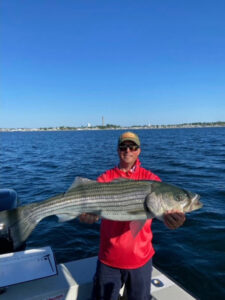Striped bass fishing is heating up in the bay, and Billingsgate Shoals is the place to be. A few days ago there were a lot of bass off Wood End Light. They were in deep water and chasing mackerel, which are everywhere, but Billingsgate was the hot spot.
Many charter boat captains are reporting that a lot of the fish being caught are over the slot size. Capt. Nico of Cape Tip’N said every fish brought in during one outing down on the shoals last week measured 35 to 40 inches. I guess that’s good news, but it’s still frustrating to the customers who can’t take a fish home to eat after a great fishing day. And as I’ve written before, we’re going to lose a significant number of these fish that are caught and released.

Flounder fishing is steadily improving from off the Pamet in 30 feet of water down to the south end of Billingsgate. Surface temperatures have warmed up fast and are approaching the 60-degree mark in some portions of the bay. There have been no bluefish catches reported yet on the Outer Cape, but they are close by and it’s just a matter of time before we see them here.
There have been two items in the news from far away that could have relevance to our neck of the woods.
A study conducted by the Institute for the Oceans and Fisheries at the University of British Columbia has found that cod stocks are improving to the point of returning to their historical migration patterns. There’s been a moratorium on cod fishing in Canada since the collapse of 1992, with only a small so-called stewardship fishery up there. But this could mean changes ahead.
This study followed 90 large northern cod, which were tagged to transmit data to satellites for over a year. The return of the cod to its traditional migration pattern coincides with an increased presence of capelin, which is a major food source and would influence cod’s presence in inshore waters. I’m hopeful this means we could be seeing changes in cod populations here.
And this just in from the Mediterranean: there’s finally a theory about the reasons behind the perplexing pattern of orcas ramming boat rudders (and yes, it is always the rudder). This is a phenomenon that has been studied for about five years. Now, a report released by the International Whaling Commission at its March meeting in Madrid is circulating in the media. It suggests these whales are simply playing — playing that has resulted in multiple boat sinkings.
Observers note that the whales ramming boats are predominately young males. And here is where I see a connection to our waters: one of the reasons they’re bored and have so much time for play is that their food source, bluefin tuna, is becoming plentiful again. The orcas don’t have to spend nearly as much time hunting them as they have had to do in recent years. Bluefin tuna rebounding over there could mean higher numbers of bluefin tuna here. These remarkable pelagic fish do cross the Atlantic Ocean east to west and back again.
Bluefin tuna and codfish are two important Cape Cod fisheries and hearing these stories of success elsewhere gives us a little hope that we’ll see improvements here as well.



